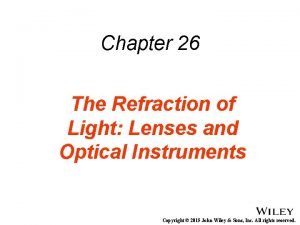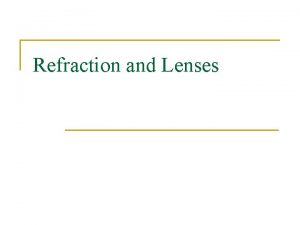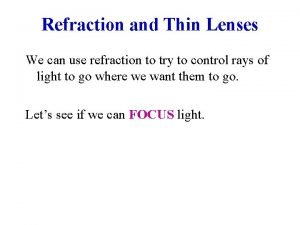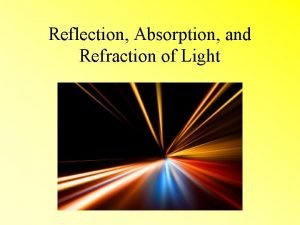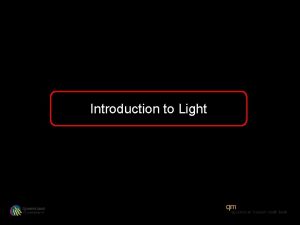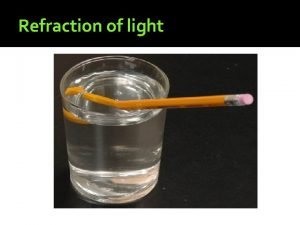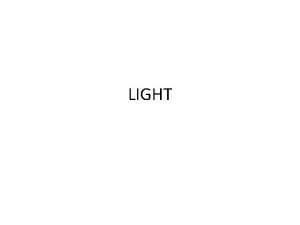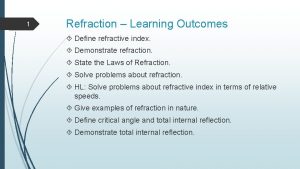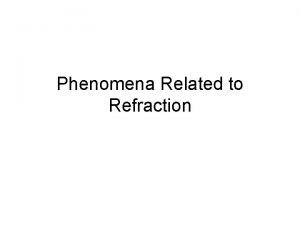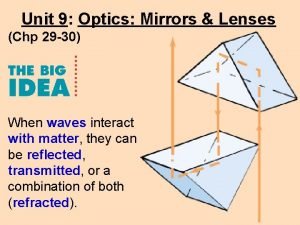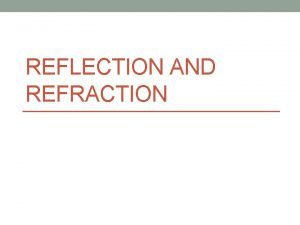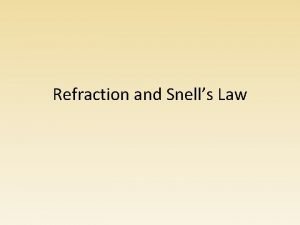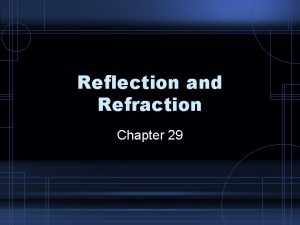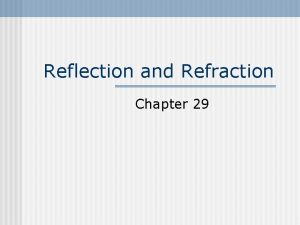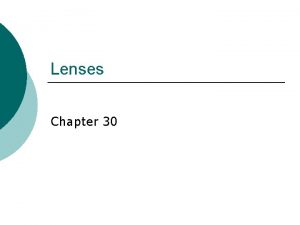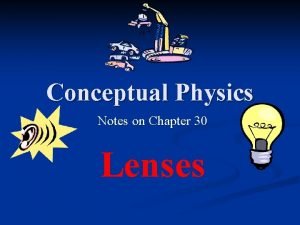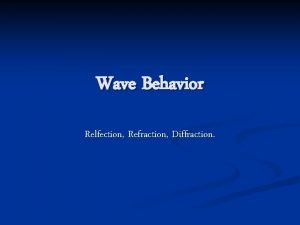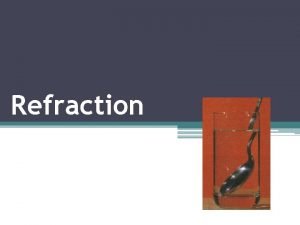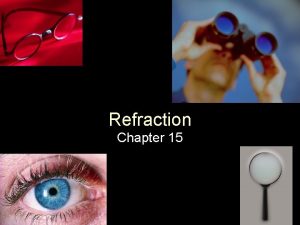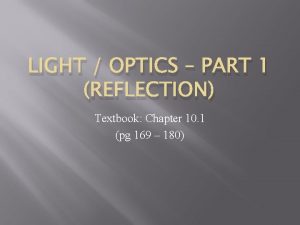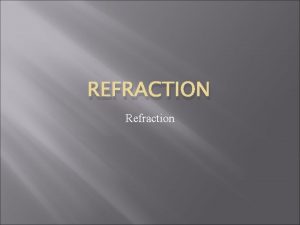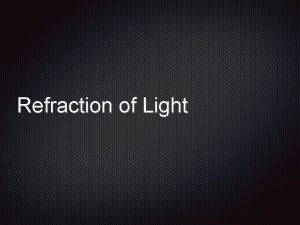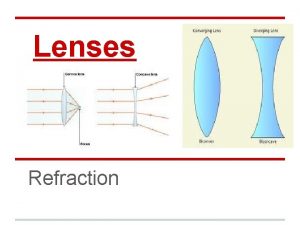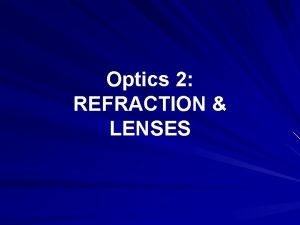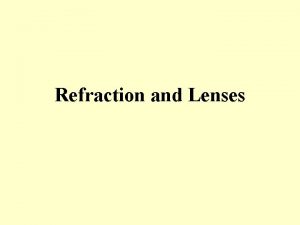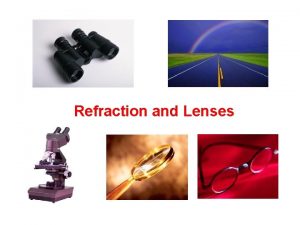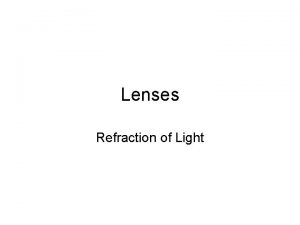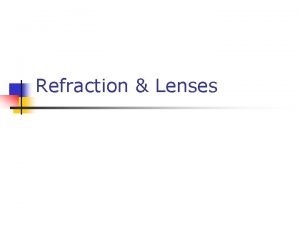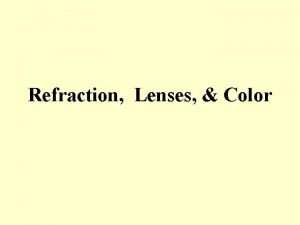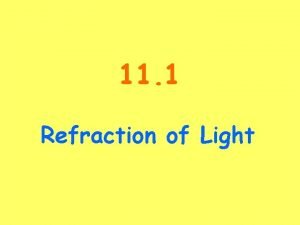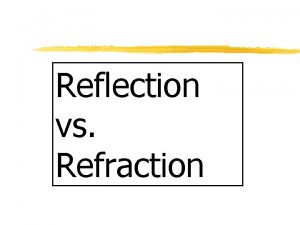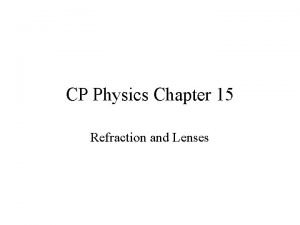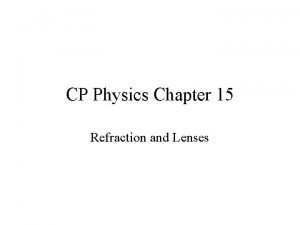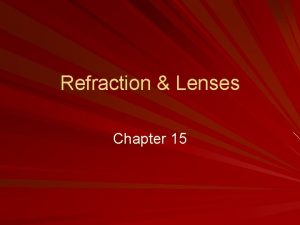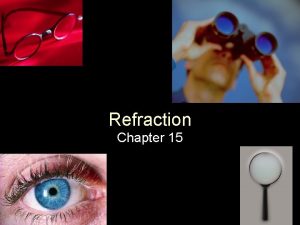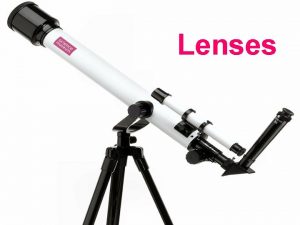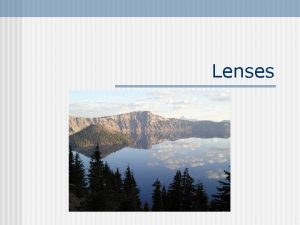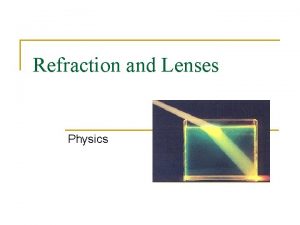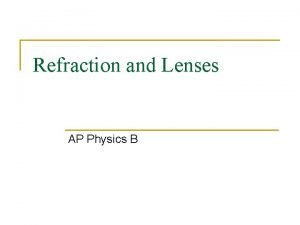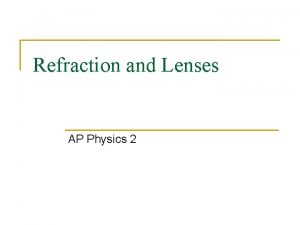Chapter 26 The Refraction of Light Lenses and

































- Slides: 33

Chapter 26 The Refraction of Light: Lenses and Optical Instruments Copyright © 2015 John Wiley & Sons, Inc. All rights reserved.

The Index of Refraction Light travels through a vacuum at a speed Light travels through materials at a speed less than its speed in a vacuum. Refraction is the change in the speed of light as it travels from one medium to another. DEFINITION OF THE INDEX OF REFRACTION The index of refraction of a material is the ratio of the speed of light in a vacuum to the speed of light in the material: Copyright © 2015 John Wiley & Sons, Inc. All rights reserved.

The Index of Refraction Copyright © 2015 John Wiley & Sons, Inc. All rights reserved.

Snell’s Law and the Refraction of Light SNELL’S LAW OF REFRACTION When light travels from a material with one index of refraction to a material with a different index of refraction, the angle of incidence is related to the angle of refraction by θ 1 represents the angle of incidence θ 2 represents the angle of refraction n 1 represents refractive index of first medium in which incident ray travels. n 2 represents the refractive index of second medium in which the refracted ray travels. Copyright © 2015 John Wiley & Sons, Inc. All rights reserved.

Snell’s Law and the Refraction of Light Example 1 Determining the Angle of Refraction A light ray strikes an air/water surface at an angle of 46 degrees with respect to the normal. Find the angle of refraction when the direction of the ray is (a) from air to water and (b) from water to air. Copyright © 2015 John Wiley & Sons, Inc. All rights reserved.

Snell’s Law and the Refraction of Light (a) (b) Copyright © 2015 John Wiley & Sons, Inc. All rights reserved.

Snell’s Law and the Refraction of Light APPARENT DEPTH Example 2 Finding a Sunken Chest The searchlight on a yacht is being used to illuminate a sunken chest. At what angle of incidence should the light be aimed? Copyright © 2015 John Wiley & Sons, Inc. All rights reserved.

Snell’s Law and the Refraction of Light Copyright © 2015 John Wiley & Sons, Inc. All rights reserved.

Snell’s Law and the Refraction of Light Apparent depth, observer directly above object d’ represents the apparent depth d represents the real depth. n 1 represents the refractive index of the medium associated with the incident ray. n 2 represents the medium associated with the refracted ray. Copyright © 2015 John Wiley & Sons, Inc. All rights reserved.

Snell’s Law and the Refraction of Light Conceptual Example 4 On the Inside Looking Out A swimmer is under water and looking up at the surface. Someone holds a coin in the air, directly above the swimmer’s eyes. To the swimmer, the coin appears to be at a certain height above the water. Is the apparent height of the coin greater, less than, or the same as its actual height? Refer to Page 725 of Textbook, Figure 26. 5 Copyright © 2015 John Wiley & Sons, Inc. All rights reserved.

Snell’s Law and the Refraction of Light THE DISPLACEMENT OF LIGHT BY A SLAB OF MATERIAL Copyright © 2015 John Wiley & Sons, Inc. All rights reserved.

Total Internal Reflection When light passes from a medium of larger refractive index into one of smaller refractive index, the refracted ray bends away from the normal. Critical angle Copyright © 2015 John Wiley & Sons, Inc. All rights reserved.

Total Internal Reflection Copyright © 2015 John Wiley & Sons, Inc. All rights reserved.

The Dispersion of Light: Prisms and Rainbows The net effect of a prism is to change the direction of a light ray. Light rays corresponding to different colors bend by different amounts. Copyright © 2015 John Wiley & Sons, Inc. All rights reserved.

The Dispersion of Light: Prisms and Rainbows Copyright © 2015 John Wiley & Sons, Inc. All rights reserved.

The Dispersion of Light: Prisms and Rainbows Copyright © 2015 John Wiley & Sons, Inc. All rights reserved.

Lenses refract light in such a way that an image of the light source is formed. With a converging lens, paraxial rays that are parallel to the principal axis converge to the focal point. Copyright © 2015 John Wiley & Sons, Inc. All rights reserved.

Lenses With a diverging lens, paraxial rays that are parallel to the principal axis appear to originate from the focal point. Copyright © 2015 John Wiley & Sons, Inc. All rights reserved.

Lenses Copyright © 2015 John Wiley & Sons, Inc. All rights reserved.

The Formation of Images by Lenses RAY DIAGRAMS Copyright © 2015 John Wiley & Sons, Inc. All rights reserved.

The Formation of Images by Lenses IMAGE FORMATION BY A CONVERGING LENS In this example, when the object is placed further than twice the focal length from the lens, the real image is inverted and smaller than the object. Copyright © 2015 John Wiley & Sons, Inc. All rights reserved.

The Formation of Images by Lenses When the object is placed between F and 2 F, the real image is inverted and larger than the object. Copyright © 2015 John Wiley & Sons, Inc. All rights reserved.

The Formation of Images by Lenses When the object is placed between F and the lens, the virtual image is upright and larger than the object. Copyright © 2015 John Wiley & Sons, Inc. All rights reserved.

The Formation of Images by Lenses IMAGE FORMATION BY A DIVERGING LENS A diverging lens always forms an upright, virtual, diminished image. Copyright © 2015 John Wiley & Sons, Inc. All rights reserved.

The Thin-Lens Equation and the Magnification Equation Copyright © 2015 John Wiley & Sons, Inc. All rights reserved.

The Thin-Lens Equation and the Magnification Equation Summary of Sign Conventions for Lenses Copyright © 2015 John Wiley & Sons, Inc. All rights reserved.

The Thin-Lens Equation and the Magnification Equation Example 9 The Real Image Formed by a Camera Lens A 1. 70 -m tall person is standing 2. 50 m in front of a camera. The camera uses a converging lens whose focal length is 0. 0500 m. (a) Find the image distance and determine whether the image is real or virtual. (b) Find the magnification and height of the image on the film. (a) real image (b) Note ho = 1. 7 m not 2. 5 m Copyright © 2015 John Wiley & Sons, Inc. All rights reserved.

Lenses in Combination The image produced by one lens serves as the object for the next lens. Copyright © 2015 John Wiley & Sons, Inc. All rights reserved.

The Human Eye ANATOMY Copyright © 2015 John Wiley & Sons, Inc. All rights reserved.

The Human Eye OPTICS The lens only contributes about 20 -25% of the refraction, but its function is important. Copyright © 2015 John Wiley & Sons, Inc. All rights reserved.

The Human Eye NEARSIGNTEDNESS The lens creates an image of the distance object at the far point of the nearsighted eye. Copyright © 2015 John Wiley & Sons, Inc. All rights reserved.

The Human Eye FARSIGNTEDNESS The lens creates an image of the close object at the near point of the farsighted eye. Copyright © 2015 John Wiley & Sons, Inc. All rights reserved.

The Human Eye THE REFRACTIVE POWER OF A LENS – THE DIOPTER Optometrists who prescribe correctional lenses and the opticians who make the lenses do not specify the focal length. Instead they use the concept of refractive power. Copyright © 2015 John Wiley & Sons, Inc. All rights reserved.
 Refraction of light in lenses
Refraction of light in lenses Mirror lens equation
Mirror lens equation What kind of shape
What kind of shape Light light light chapter 23
Light light light chapter 23 Into the light chapter 22
Into the light chapter 22 Chapter 22
Chapter 22 Reflection refraction absorption
Reflection refraction absorption Introduction of light reflection and refraction
Introduction of light reflection and refraction Cause of refraction of light
Cause of refraction of light A lens that curve outwards and are fatter in the middle
A lens that curve outwards and are fatter in the middle Learning objectives of refraction of light
Learning objectives of refraction of light Phenomena related to refraction of light
Phenomena related to refraction of light The action of lenses depends mainly on
The action of lenses depends mainly on When a wave reaches a boundary it
When a wave reaches a boundary it Refraction of light
Refraction of light Light refraction
Light refraction Noise and light discipline
Noise and light discipline Rainbow total internal reflection
Rainbow total internal reflection Chapter 29 reflection and refraction
Chapter 29 reflection and refraction Chapter 30 lenses
Chapter 30 lenses Chapter 30 conceptual physics
Chapter 30 conceptual physics Put out the light and then
Put out the light and then Bacteria double membrane
Bacteria double membrane It is the bouncing off of light
It is the bouncing off of light Reflection wave behavior
Reflection wave behavior Poetry reaction
Poetry reaction Partial reflection and refraction examples
Partial reflection and refraction examples Bill nye light
Bill nye light Invictus poem reflection
Invictus poem reflection Raindrops sunlight and refraction lyrics
Raindrops sunlight and refraction lyrics Bill nye light optics worksheet
Bill nye light optics worksheet Venn diagram of geometric optics and physical optics
Venn diagram of geometric optics and physical optics Formula for venn diagram with 3 circles
Formula for venn diagram with 3 circles Massless bundles of concentrated energy
Massless bundles of concentrated energy
